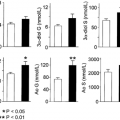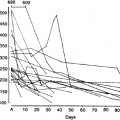ADIPOSE TISSUE GROWTH AND DEVELOPMENT
Part of “CHAPTER 126 – OBESITY“
EARLY GROWTH OF ADIPOSE TISSUE
Normal growth of human adipose tissue is achieved through an increase in adipocyte size and number. Histologic studies, as well as studies of adipocyte development in tissue culture, strongly suggest that the precursor cell, or adipoblast, is a cell that is indistinguishable from the fibroblast. The replication of preadipocytes and their differentiation into mature adipocytes have been shown to be affected by epidermal growth factor, insulin, glucocorticoids, and PPARγ.19 This gene encodes two proteins, PPARγ1 and PPARγ2. The latter is found in adipose tissue and is believed to play a role in adipocyte differentiation. Adipose cells first appear at approximately the 15th week of human gestation, continue to appear in large numbers until approximately 23 weeks of gestation, and then appear more slowly throughout the remainder of gestation. During the first 2 years of life, adipose tissue mass grows by an increase in both cell size and number. Cell number rises slowly from 2 years of age until close to the onset of puberty, and during adolescence, there is another sharp elevation in cell number that accounts for a second spurt in the growth of the adipose tissue mass. Thereafter, the size of adipose tissue of nonobese adults maintaining constant body weight remains stable, as do adipose cell size and number. The size of adipose cells within nonobese individuals can differ considerably from one fat depot to another. In a large group of nonobese healthy subjects, cell size in six separate fat depots ranged from 0.14 to 0.68 μg of lipid per cell, with a mean size of 0.41 μg lipid per cell.20 The average total cell number in this nonobese population was 30 × 109.
Stay updated, free articles. Join our Telegram channel

Full access? Get Clinical Tree





